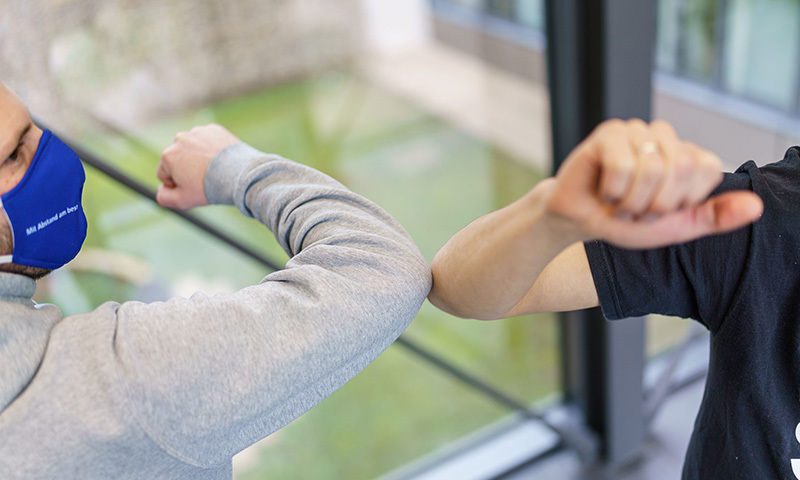News
Unspoken Promises in the Time of Corona
[26.02.2021]Elbow bumps, “foot-shakes,” hand waves: How do people agree on one of the new forms of greeting? Prof. Dr. Dorett Funcke of the FernUniversität investigated this question.
 Photo: Volker Wiciok
Photo: Volker Wiciok
The effects of social distancing due to the coronavirus pandemic include – in addition to drastic changes to our everyday lives – a variety of often unconscious changes to our behavior. For example, at the beginning of 2020, who (besides boxing fans) would have considered a fist bump their standard greeting? In addition to fist bumps, elbow bumps, “foot-shakes,” hand waves, head nods, placing a hand over the heart, the namaste gesture, and other new greeting rituals have replaced handshakes, hugs, and kisses on the cheek. “How do people agree on one of the many new forms of greeting, and what are the implications of that?” asked Prof. Dr. Dorett Funcke, head of the Ernsting’s Family Endowed Professorship of Microsociology at the FernUniversität in Hagen. After all, in many different areas of our lives, many of the usual rules and conventions no longer apply.
Because personal and physical closeness are difficult to combine due to the coronavirus crisis, we now often have to wordlessly shape our mutual relationships by expressing agreement through gestures, for example through “simultaneously communicated opposition” (naturally, we can also express rejection). “Distanced communication,” then, is often achieved only through gestures and facial expressions, and is made more difficult by face masks. A handshake, by contrast, has a fixed form and minimum and maximum distances.
Building a communicative relationship while simultaneously being required to maintain distance is a strenuous situation. It requires highly complex actions and reactions in the space of a split second in order to initiate or reinforce a positive relationship.
What Is the Basic Function of a Greeting?
 Photo: Volker Wiciok
Photo: Volker Wiciok
One of humans’ unique features is their ability to cooperate: “Through their actions, they create a ‘cooperative sociality,’” said Dorett Funcke. People show how willing to cooperate they are through how they position themselves in a space. Feelings of closeness or distance between people are also expressed spatially: Do they touch each other or do they keep their distance? According to the sociology of space (Georg Simmel, 1858–1918), how people define their relationships to one another is not determined just by physical space, but also by space in the sense of constellations of relationships. “Nearness stands for close communication and distance for unfamiliarity,” explained Dorett Funcke. “So we express how close we are to one another in the figurative sense through our physical positioning.”
The smallest unit of communication which achieves sociality, or associating in a social community, is an exchange of greetings. Greetings establish a mutual relationship – as a promise of continuity, they bind people to it.
According to Funcke: “We tend to accompany this microcommunication – especially when we particularly like one another – with a hug, a kiss on the cheek, or a handshake. With such ‘embodied conventions,’ we reinforce communication. These actions follow common conventions, and with them we express our binding positive mutual positioning.”
Highly Complex Actions and Reactions
In our current day-to-day interactions, people respond reflexively to the new challenges, observed Prof. Funcke during the “corona year” 2020. The (spatial) boundary between people who greet each other, although it is often drawn wordlessly, is still created communicatively and is an object of reflection: We consider at a lightning pace how closely to approach someone, while at the same time observing the other person’s behavior and accounting for it in our own actions and reactions.
Additionally, the FernUni researcher found that new forms have become more important: “These nonverbal gestures, which are shorthand versions of a greeting, should partially replace greetings that involve physical closeness. With these forms, communication crises that could arise from the loss of conventional forms of exchange can be prevented, and the positive relationship can be reinforced. They also symbolize a promise of continuity and bind people to their mutual relationship.”
Communication – More than Words
While the basic medium of communication for mutual exchange is speech, body language is also used as a medium, for example through movements toward or away from a communication partner. We also react to communication problems with laughter, crying, blushing, and other forms of physical expression – often without realizing it.
Willingness to engage in reciprocity and communication, that is, acting in relation to one another, is guided by rules and determined by specific qualities. This applies to all forms of greeting.
What is the difference between a “physically close” greeting with a handshake and a “distanced” greeting without one? According to Funcke: “With the handshake and greeting from both sides, such as an exchange of ‘Hello!’s, a ‘physically close’ greeting emphasizes the promise to enter into a mutual relationship. This can take place through questions like ‘How’s it going?,’ ‘What are you up to?,’ or ‘Where are you going?,’ for example.” The handshake represents an affirmation, but the difference between a greeting without a handshake and no greeting at all is minimal.
Rules and Norms
Nearness stands for close communication and distance for unfamiliarity. So we express how close we are to one another in the figurative sense through our physical positioning
Prof. Dorett Funcke
“In sociology, we differentiate strictly between rules and norms,” explained Funcke. The difference, according to the researcher, is very important in order to clearly recognize what is a real change or transformation: “A change to a norm does not automatically mean a rule has been broken. Certain elementary rules do not change, even if people violate them by no longer following a once-common norm.”
That people of a lower status, for example, should offer a greeting first, or younger people should greet older people, men should greet women, is related to the structure of greeting itself. Greetings (for example, “Good morning,” “Hello,” etc.) open up exactly two options for the person who is greeted: to return the greeting or not. The person who offers the greeting takes a risk, because they can be denied a greeting in return: The person being greeted thus rejects a mutual relationship. In practice, this is a negative sanction. “Higher-ranking people, by virtue of their status, must be allowed to decide if they want to enter into the minimal form of an encounter with a greeting, while, to put it in simple terms, we want to protect women and older people from a ‘snub,’” Funcke explains one purpose of the greeting rules. “A greeting always includes an assumption of autonomy and – in connection with this autonomy and created by the greeting rule in the first place – freedom to decide.” Only, however, under the constraint of the rules that are in force.
For the new greeting rituals, too, rules apply. However, the form they take can change. “This is then due to the fact that people no longer follow certain norms that are affected by social change, or – as in the time of the coronavirus crisis – no longer are able to follow them.”

